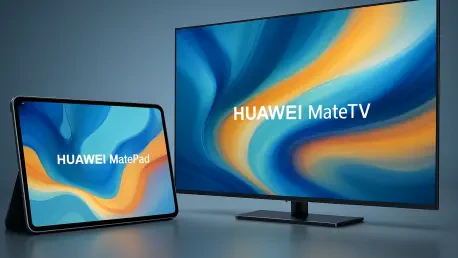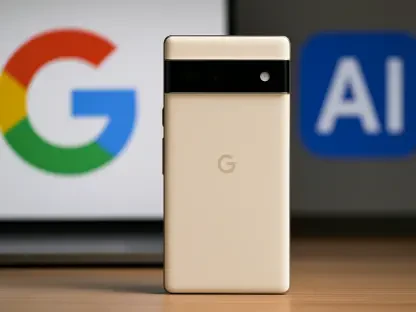Imagine a world where compact tablets rival the power of full-sized devices, and smart TVs transform into interactive hubs for gaming, education, and entertainment—all from a single brand pushing the boundaries of innovation. Huawei has stepped into this arena with the MatePad Mini and MateTV series, delivering premium technology tailored for niche markets. This review explores how these devices stand out in a crowded tech landscape, offering unique features that cater to diverse user needs with a focus on performance and versatility.
Huawei MatePad Mini: Compact Powerhouse
Display and Build Quality
The Huawei MatePad Mini redefines what a small tablet can achieve with its 8.8-inch OLED display, boasting a crisp 2,560 x 1,600 resolution and a smooth 120Hz refresh rate. With a peak brightness of 1,800 nits and HDR Vivid certification, the screen ensures vivid visuals even in challenging lighting conditions. A specialized Soft Light variant further reduces reflectivity, making it ideal for extended reading or outdoor use.Physically, the tablet impresses with its sleek dimensions of 198.6 x 127.3 x 5.1mm and a featherlight weight of 255g. This compact design makes it effortless to carry, fitting comfortably in a bag or even a large pocket, while still offering a premium build that feels durable in hand.
Performance and Battery Efficiency
Under the hood, the MatePad Mini runs on HarmonyOS 5.1, paired with 12GB of RAM and storage options of 256GB or 512GB. While the specific chipset remains undisclosed, the tablet handles multitasking and media consumption with ease, though questions linger about its performance in benchmark-heavy tasks. This ambiguity might concern power users seeking detailed specs for comparison.The 6,400mAh battery stands out, delivering up to 15.5 hours of video playback on a single charge. Coupled with 66W fast charging, the device minimizes downtime, ensuring users stay connected and productive throughout the day, whether for work or leisure.
Connectivity and Standout Features
Connectivity is a highlight, with support for cellular networks and two-way satellite messaging through the BeiDou system, a rare feature that proves invaluable in remote areas. The inclusion of Wi-Fi 7, Bluetooth 5.2, and Huawei’s StarFlash technology further enhances its modern appeal, promising fast and reliable data transfer.Beyond connectivity, the MatePad Mini offers a 32MP front camera for sharp video calls and a dual rear setup with a 50MP main and 8MP ultra-wide lens, capable of 4K recording. Add in a side-mounted fingerprint sensor, stereo speakers, and compatibility with the M-Pencil Pro stylus, and this tablet becomes a versatile tool for creators and professionals alike.
Pricing and Market Availability
Starting at CNY 4,000 (approximately $560) for the base model and reaching CNY 5,000 ($700) for the top-tier Soft Light variant, the MatePad Mini positions itself in the premium segment of compact tablets. Color options like Obsidian Black, Snow White, and Spruce Green add a touch of personalization, though availability varies by configuration. This pricing reflects the advanced features on offer, targeting users willing to invest in high-end portable tech.
Huawei MateTV Series: Redefining Smart Entertainment
Advanced Display and Size Variants
The MateTV series, encompassing both standard and Pro models, brings cinema-quality visuals to the home with Super miniLED displays. Sizes range from 65 to 98 inches for the standard MateTV and 75 to 98 inches for the Pro, catering to a variety of room sizes and preferences. The Pro model elevates the experience with an anti-reflective coating, minimizing glare in bright environments.A unique floating touch functionality on the Pro variant allows for intuitive interaction, making navigation and app usage more engaging. This focus on display innovation positions the MateTV series as a serious contender in the high-end smart TV market, appealing to those seeking immersive viewing experiences.
Hardware Specs and Audio Immersion
Performance-wise, both models rely on an unnamed mobile chipset, with the standard MateTV equipped with 8GB of RAM and 128GB of storage, while the Pro steps up to 12GB of RAM and 256GB of storage. This hardware ensures smooth operation across streaming, gaming, and other demanding applications, though the lack of chipset specifics may raise eyebrows among tech enthusiasts.Audio capabilities are equally impressive, with the standard model featuring a 2.2 setup of six speakers delivering 120W of power, while the Pro offers a 3.2.2 configuration with nine speakers, including upward-firing units, for a robust 180W output. This setup creates a surround sound effect that enhances movies and games, making every scene more captivating.
Innovative Interaction Methods
Control options for the MateTV series go beyond the conventional, offering a standard remote with air mouse functionality for precise navigation. A stylus caters to professional and educational use cases, allowing for annotations or interactive lessons directly on the screen, while a gaming-focused touch controller with shoulder buttons and a large touchpad targets avid gamers.This variety in control mechanisms reflects a thoughtful approach to user interaction, ensuring the TVs adapt to different scenarios, from casual viewing to specialized tasks. Such versatility broadens the appeal, setting the MateTV apart from competitors with more static interfaces.
Cost and Competitive Positioning
Pricing for the MateTV series starts at CNY 9,000 (around $1,260) for the 65-inch standard model, climbing to CNY 31,000 (about $4,340) for the 98-inch Pro variant. This places the series firmly in the premium category, targeting consumers and professionals who prioritize cutting-edge features over budget considerations. The cost aligns with the advanced technology embedded in these TVs, though it may limit accessibility for some markets.
Strategic Trends in Huawei’s Portfolio
Huawei’s approach with these devices underscores a commitment to blending advanced technology with targeted functionality, addressing specific user demands across different product scales. The MatePad Mini caters to those needing portability without sacrificing power, while the MateTV series focuses on transforming large-screen experiences with interactive and immersive features. This dual focus highlights a trend toward specialization in tech offerings.A deeper look reveals an emphasis on premium display quality, whether in compact or oversized formats, alongside enhanced connectivity options like satellite messaging and Wi-Fi 7. These elements suggest Huawei is carving a niche by prioritizing innovation in areas often overlooked by mainstream competitors, aiming to redefine user expectations.
Practical Uses and Target Audiences
For on-the-go professionals, students, or travelers, the MatePad Mini offers a compelling solution with its lightweight design and robust feature set, including satellite messaging for connectivity in remote locations. Its powerful cameras and stylus support make it suitable for content creation, note-taking, and virtual meetings, bridging the gap between convenience and capability.Meanwhile, the MateTV series excels in home entertainment, delivering theater-like visuals and sound for movie buffs and gamers. Its interactive controls also open doors to educational and professional applications, such as virtual classrooms or collaborative workspaces, making it a multifaceted tool for modern households and offices.
Potential Drawbacks and Hurdles
Despite its strengths, the MatePad Mini faces challenges, notably the undisclosed chipset, which could deter tech-savvy buyers seeking transparency in performance metrics. Additionally, the mini-tablet market remains competitive, with established players potentially overshadowing Huawei’s entry despite its unique offerings.The MateTV series, while innovative, contends with high pricing that may restrict its reach to a narrower, affluent audience. The effectiveness of interactive features also depends on robust ecosystem support, an area where Huawei must continue to build to ensure seamless user experiences and broader adoption.
Looking Ahead: Huawei’s Tech Trajectory
As Huawei refines its device lineup, potential upgrades to the MatePad Mini could include clearer chipset specifications and expanded software capabilities to boost performance transparency. Broader global availability might also help it compete more effectively against dominant tablet brands over the coming years.For the MateTV series, future iterations could focus on integrating even more advanced display technologies and refining control mechanisms to enhance usability. Huawei’s trajectory suggests a sustained push toward redefining niche markets, potentially influencing how consumers perceive premium tablets and smart TVs through innovative connectivity and interaction.
Final Thoughts
Reflecting on this evaluation, the Huawei MatePad Mini and MateTV series stand out for their bold approach to niche technology segments, blending high-end specifications with specialized features. The compact tablet impresses with its portability and connectivity, while the smart TVs redefine large-screen engagement through immersive audio-visuals and versatile controls.Moving forward, Huawei could focus on addressing chipset transparency for the tablet and expanding ecosystem support for the TVs to maximize their potential. Exploring more accessible price points or bundled offerings might also widen their market reach, ensuring these innovative devices find their way into more hands and homes.









